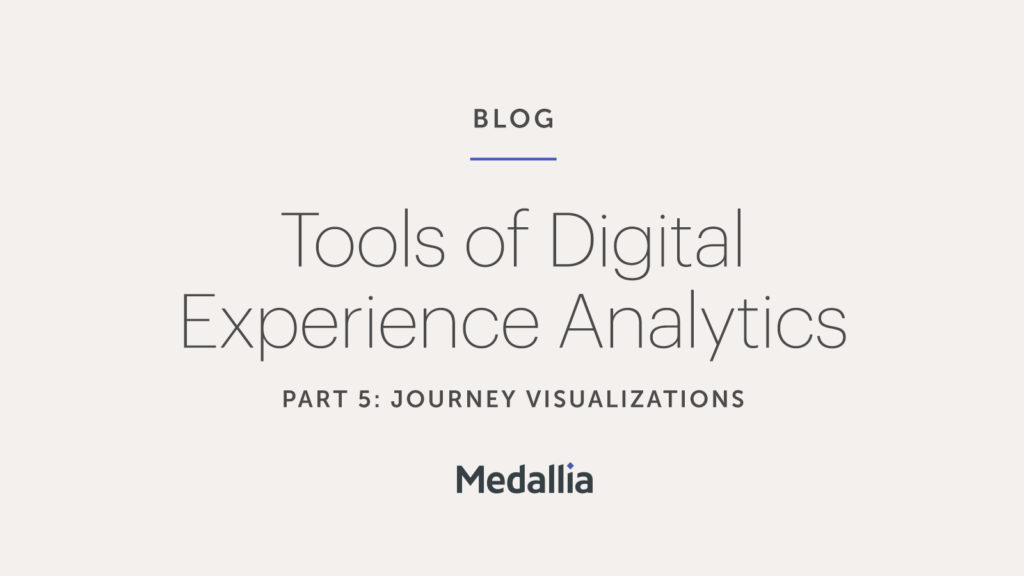No two digital experiences are the same on websites and apps. Journey visualizations, a digital experience analytics tool, cut down on the time and resources required for online customer experience journey mapping.
This is the final part of Medallia’s five-part blog series, Tools of Digital Experience Analytics, where we’ve covered digital experience scores, heatmaps, session replay, and form analytics. And now we’re wrapping up the series with this final blog on journey visualizations tools.
Common thinking around online customer behavior is that website and app users often follow familiar, defined paths. However, when you look at the journeys visitors actually take, the reality is those journeys are complicated and often different. To truly understand unpredictable online customer journeys and behaviors, journey visualization tools have become essential in today’s digital-first world.
While similar at the surface, journey visualization tools differ from popular tools like funnels, which are commonly included in web or app analytics. Funnels track key metrics, like engagement and traffic, at specific stages in a predefined journey. Whereas journey visualizations track every online customer journey taking place on a website or app.
What Is Customer Experience Journey Mapping?
Customer experience journey mapping is a visual representation of the customer’s interactions with, emotions felt, and behaviors observed across all touchpoints on websites and apps. This mapping provides insights into how customers engage with digital channels, helping companies understand where customers are facing challenges or improvements that need to be made to create a seamless digital experience. Journey visualization tools make this process easier by providing visual representations of individual customer journeys, allowing businesses to easily identify pain points and make data-driven decisions to improve the overall customer experience.
The Importance of Customer Personas in Journey Mapping
Customer personas play a significant role in customer experience journey mapping. These personas are fictional representations of your ideal or target customer, developed based on market research and data you’ve gathered about your existing clients. Personas create a face and a voice for your customer data, helping teams understand and empathize with the real individuals behind each interaction with a company’s website or app. When combined with journey visualization tools, customer personas can further enhance the journey mapping process.
Evaluating the Digital Customer Experience
By monitoring the following digital customer experience KPIs, businesses can gain a better understanding of their customers’ overall experience, identify areas for improvement, and make data-driven decisions to enhance the customer journey.
Top & Digital Experience KPIs
- Time on Page: How long visitors spend on each page before moving onto the next.
- Conversion Rates: The percentage of visitors who complete a desired action on your website or app.
- Repeat Visits: The number of times individual customers return to your website or app, indicating their level of satisfaction with your brand, products, or services.
- Customer Retention: The ability of a business to retain existing customers by providing a positive customer experience.
- Customer Lifetime Value: How much revenue a customer generates for a business over their lifetime.
- Net Promoter Score (NPS®): A measure of customer satisfaction and loyalty.
- Customer Effort Score (CES): The level of effort required to complete a desired action.
What Are Customer Experience Journey Mapping Tools?
Journey visualization tools provide a comprehensive way to track the routes users take on a website or an app, from start to finish. They automatically map every webpage or app screen that constitutes a customer’s online journey. Typically, they are included within a broader digital experience analytics solution. These tools offer a high-level overview by identifying and visualizing the precise paths users navigate.
Sunburst visualizations, a key feature of these tools, present an array of journey segments in a circular graph, representing every unique pathway followed by users. This simplifies large complex data sets into an easily digestible format, enabling teams to quickly identify bottlenecks as well as the quickest paths to conversion.
In addition to sunburst visualizations,, More advanced journey visualization tools often offer standard conversion funnels, as discussed above, as well as other measures of digital experience and engagement, such as behavior detection that highlights engagement, frustration, and confusion at critical points in each journey. These insights are often supplemented by:
- A digital experience score to quantify the experiences for each journey segment
- Session replays: Video recordings that visualize the specific actions customers take as they browse your website or app, including their clicks and page scrolling behavior
- Heatmaps of aggregate on-page or in-app user behavior that can be used to investigate specific journey issues on certain pages
Why Use Customer Experience Journey Mapping Visualization Tools?
In an era in which websites and apps play such an integral role in customer experience, mapping out and enhancing online customer journeys have become critical activities. In fact, taking a journey-based approach to optimizing the customer experience is a high priority for organizations. Journey visualizations, in this context, make adopting a journey-based approach both practical and effective.
Without a journey visualization tool, online customer journey mapping requires tedious, time-consuming efforts tracking metrics across pages to determine areas in journeys worth improving. However, journey visualization tools can take care of that for you by automatically tracking and mapping out those digital customer journeys, minimizing both resources used and inaccuracies associated with manual mapping.
Not only do these tools increase efficiency, they also help pinpoint the quality of digital experiences across each unique journey. For instance, Medallia’s journey visualization tool, part of our behavior intelligence and digital experience solutions, provides a digital experience score that rates the quality of a customer’s web or app journey, thereby distinguishing high-performing journeys from low-performing ones. Paired with behavior detection, it’s easier to spot underperforming journeys that trigger instances of frustration and confusion.
On top of that, a customer experience journey mapping allows you to assess how different factors affect visitor navigation. For instance, you can compare the user journeys of specific personas or segments, choose whether to view sessions by URL or page groups, or view journeys across any given time period. All of these options make finding and fixing even the most subtle source of friction in the customer journey more manageable.
Optimizing Use of Customer Experience Journey Mapping Tools
To make the most of this digital experience analytics tools, be sure to leverage journey visualization tools when you see your company’s digital experience metrics, such as abandonment, conversions, or digital experience scores, are getting worse across your website or app. As you do, follow this simple seven-step process to maximize your journey visualization insights and optimize your overall digital experience:
1. Monitor Analytics Metrics
Monitor web and app analytics metrics to discover when friction arises in your customers’ online journeys.
2. Score Digital Experience Journeys
Identify good and bad journeys using a metric like Medallia’s digital experience score to rate each path.
3. Identify Pain Points
Pinpoint specific paths and pages that are generating frustration and confusion as indicated using behavior detection that can automatically single out acts of user desperation, such as bird’s nest behavior, and evaluate digital frustration scores.
4. Use Segmentation Filters
Use segmentation filters to narrow insights around specific journey criteria and experiences.
5. Analyze Funnels in Conversion Paths
Check funnels to uncover dropoff in paths leading to conversion pages.
6. Review Sunburst Visualizations
Review sunburst visualizations to determine journeys worth investigating and optimizing.
7. Investigate High-Friction Journeys
Further examine high-friction journeys using tools like heatmaps and session replay.
6 Features to Consider in a Journey Mapping Tool
Improving online customer journeys across websites and apps has become foundational to building an omnichannel customer experience strategy. As a result, journey mapping and journey visualization tools have become a high priority. But what capabilities actually matter? Here are the six features you should seek in the solutions you consider:
- Sunburst visualizations to automatically show user paths for easy journey mapping on websites and apps.
- Funnels to track dropoff and engagement at various stages of conversion journeys.
- Digital experience scoring to instantly determine the experience quality of every journey.
- Behavior detection to pinpoint journeys and pages causing experience issues in the moment.
- Segmentation to customize path analysis and focus on specific journeys of interest.
- Forensic tools like session replay and heatmaps for granular experience investigations.
Elevate Your Customer Experience Journey Mapping with Medallia
Connect with one of our Medallia experts to learn how our advanced journey visualization tools can empower your team to make data-driven decisions and enhance your brand’s omnichannel customer journey.







